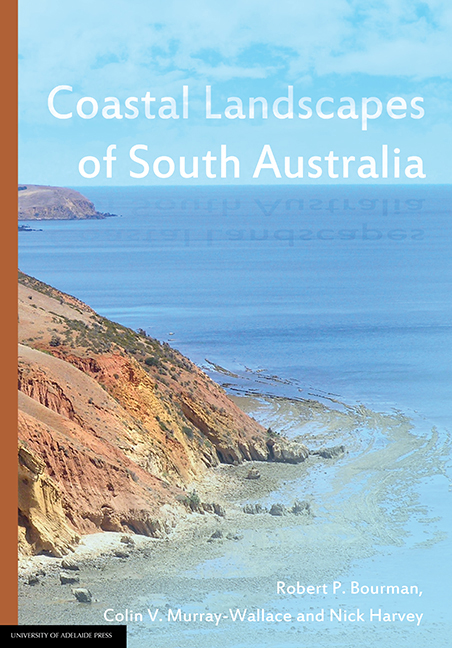Book contents
- Frontmatter
- Dedication
- Contents
- Preface
- Biographies
- Acknowledgements
- 1 Coastal landscapes of South Australia
- 2 The coast of metropolitan Adelaide
- 3 The Fleurieu Peninsula coast
- 4 The River Murray Estuary
- 5 The Coorong Coastal Plain and the Limestone Coast
- 6 The northern Gulf St Vincent tidal coastline (the Samphire Coast)
- 7 The Yorke Peninsula coastline
- 8 The northern Spencer Gulf coast
- 9 The Gulf Coast of Eyre Peninsula
- 10 The Bight Coast - West coast of Eyre Peninsula
- 11 Kangaroo Island
- 12 Explaining the coastal landscapes of South Australia - A synthesis
5 - The Coorong Coastal Plain and the Limestone Coast
Published online by Cambridge University Press: 25 July 2017
- Frontmatter
- Dedication
- Contents
- Preface
- Biographies
- Acknowledgements
- 1 Coastal landscapes of South Australia
- 2 The coast of metropolitan Adelaide
- 3 The Fleurieu Peninsula coast
- 4 The River Murray Estuary
- 5 The Coorong Coastal Plain and the Limestone Coast
- 6 The northern Gulf St Vincent tidal coastline (the Samphire Coast)
- 7 The Yorke Peninsula coastline
- 8 The northern Spencer Gulf coast
- 9 The Gulf Coast of Eyre Peninsula
- 10 The Bight Coast - West coast of Eyre Peninsula
- 11 Kangaroo Island
- 12 Explaining the coastal landscapes of South Australia - A synthesis
Summary
Introduction
The 400 km coastal sector from the mouth of the River Murray to the border of South Australia and Victoria is primarily a depositional coastline of low topographical relief (<50 m), dominated by coastal dunes of Late Quaternary age (<125 ka).
From the River Murray mouth area south to Cape Jaffa, the coastline is formed by the coastal barrier landform Younghusband Peninsula and the associated Coorong Lagoon. The sector from Cape Jaffa to the border is dominated by rocky coastal cliffs, developed on Pleistocene dune limestone (aeolianite) with sandy pocket beaches and shingle beaches, comprising flint cobbles to the east of Port MacDonnell. Extensive sand sheets with migrating dunes occur at many locations along this coast. In only a few localities does bedrock older than Paleogene age (>66 Ma) crop out along the coastline, such as ‘The Granites’ north of Kingston SE. No rivers reach the sea along this coastline. Relative sea level changes associated with glacial cycles of the Quaternary have accordingly promoted sediment exchange from the continental shelf to the adjacent coastline and given rise to the region's principal coastal landforms, coastal barrier systems, uplifted over tens of thousands of years. From Cape Jaffa, south to Discovery Bay in western Victoria, the coastline displays slightly higher topographical relief in places, due to uplifted outcrops of aeolianite of Late Pleistocene age. These sediments are more strongly cemented, and give rise to vertical coastal cliffs.
The sediments and landforms of the modern coastline form the latest stage of the geological development of a succession of similar but older coastal barrier landforms. The Younghusband Peninsula and the Coorong Lagoon thus provide a modern analogue of the older shoreline features, which extend 500 km inland from the modern coastline, and back in time to approximately 6 Ma as a later phase in the early sedimentary infill of the Murray and Gambier Basins (Murravian Gulf). These stranded coastal dune barriers developed at times of high sea levels during Pleistocene interglacials.
The generalised distinction between unconsolidated Holocene sediments dominating the modern coastline to the north of Cape Jaffa and consolidated Pleistocene aeolianite being more prevalent to the south reflects variable vertical crustal movements.
- Type
- Chapter
- Information
- Coastal Landscapes of South Australia , pp. 145 - 176Publisher: The University of Adelaide PressPrint publication year: 2016

